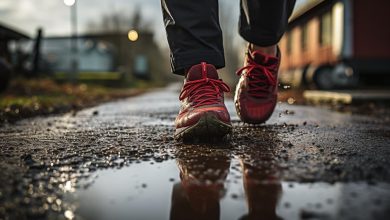The Importance of Rest and Recovery for Injury Prevention

Imagine a world where injuries never held you back from reaching your fitness goals. Picture yourself pushing through workouts with ease, free from the fear of setbacks.
The key to unlocking this reality lies in one simple concept: rest and recovery.
In this article, we will explore the science behind how rest can prevent injuries, understand the crucial role it plays in injury prevention, and provide you with effective strategies to incorporate optimal rest and recovery into your training routine.
Get ready to discover the power of taking care of your body for long-term success.
The Science Behind Rest and Recovery

You may be wondering what the science says about the benefits of rest and recovery for injury prevention. Well, let’s dive into it.
When it comes to rest and muscle growth, studies have shown that adequate rest periods between workouts are essential for optimal muscle repair and growth. Without enough rest, your muscles won’t have enough time to recover and rebuild, potentially leading to overuse injuries.
Additionally, sleep plays a crucial role in injury prevention. During sleep, our bodies release growth hormone, which is vital for tissue repair and regeneration. Lack of sleep can disrupt this process and impair the body’s ability to recover from injuries. In fact, research has found that individuals who consistently get less than seven hours of sleep per night are at a higher risk of developing sports-related injuries.
Understanding the role of rest in injury prevention is key to maintaining peak performance and avoiding unnecessary setbacks. Rest allows your body to replenish energy stores, repair damaged tissues, and reduce inflammation caused by intense physical activity. It also helps prevent mental fatigue, which can lead to poor decision-making on the field or court.
With all this evidence pointing towards the importance of rest and recovery for injury prevention, it’s clear that incorporating proper rest into your training regimen is not only beneficial but necessary for long-term success and overall well-being.
Understanding the Role of Rest in Injury Prevention

Understanding the role of taking breaks in preventing injuries is crucial. Rest plays a vital role in injury prevention and neglecting it can have serious consequences. Here are three key points to consider:
1. Promotes muscle recovery: When you engage in physical activity, your muscles undergo stress and microscopic damage. Rest allows your body to repair and rebuild these tissues, preventing further strain and reducing the risk of overuse injuries.
2. Reduces fatigue and improves performance: Rest helps alleviate mental and physical fatigue, allowing you to perform at your best. Adequate rest periods between workouts or training sessions help restore energy levels, enhance focus, and optimize athletic performance.
3. Prevents burnout and overtraining: Neglecting rest can lead to burnout and overtraining syndrome, which can have detrimental effects on both physical and mental health. Overtraining not only increases the risk of injuries but also impairs immune function, disrupts sleep patterns, decreases motivation, and hampers overall well-being.
Key Factors to Consider in Effective Recovery

One crucial aspect to keep in mind when aiming for effective recovery is the significance of adequate rest periods. Rest and recovery play a vital role in preventing injuries and optimizing performance. When your body is put under stress during exercise or physical activity, it undergoes micro-tears in the muscles and tissues. Taking time to rest allows these structures to repair and rebuild, ultimately leading to improved strength and resilience.
Restorative practices can include various techniques that promote recovery, such as stretching, foam rolling, massage therapy, and proper hydration. These techniques help reduce muscle soreness, improve flexibility, increase blood flow to the muscles, and flush out metabolic waste products. They also aid in reducing inflammation and promoting tissue repair.
To emphasize the importance of incorporating these recovery techniques into your routine, let’s take a look at this table:
| Recovery Technique | Benefits | Emotional Response |
|---|---|---|
| Stretching | Improved flexibility | Increased mobility |
| Foam rolling | Reduced muscle soreness | Relief |
| Massage therapy | Enhanced relaxation | Tranquility |
| Hydration | Replenishes fluids lost during exercise | Refreshment |
Strategies for Optimal Rest and Recovery

To maximize rest and recovery, it’s important to implement effective strategies such as proper nutrition and quality sleep. These strategies not only help athletes recover from intense training but also promote overall well-being.
Here are three techniques that can aid in optimal rest and recovery:
1. Active Recovery: Engaging in light exercises or activities on rest days can enhance blood flow, reduce muscle soreness, and facilitate the removal of metabolic waste products. Examples include low-intensity cycling, swimming, or yoga.
2. Sleep Hygiene: Establishing a consistent sleep routine and creating an ideal sleep environment promotes deep and restorative sleep. This includes maintaining a cool temperature, limiting exposure to electronic devices before bed, and ensuring a comfortable sleeping surface.
3. Nutrition: Consuming nutrient-dense foods that support muscle repair and replenish energy stores is crucial for recovery. Focus on consuming adequate protein to aid in muscle tissue repair, carbohydrates for glycogen replenishment, and healthy fats for inflammation control.
Rest and recovery techniques benefit athletes by reducing the risk of injuries caused by overtraining or fatigue. Moreover, these strategies contribute to overall well-being by improving immune function, enhancing mental health, promoting better cognitive performance, and increasing longevity in sports careers.
Incorporating Rest and Recovery Into Your Training Routine

Make sure you prioritize rest and recovery in your training routine to optimize your performance and overall well-being. Rest and recovery are crucial aspects of any training program, as they provide numerous benefits for both physical and mental health.
One of the main benefits is injury prevention. When you push your body too hard without allowing it enough time to recover, you increase the risk of overuse injuries such as stress fractures or tendonitis. Resting and giving your body time to heal can help prevent these injuries from occurring.
There are also common misconceptions about rest and recovery that need to be addressed. Some people believe that taking time off from training will result in loss of progress or decreased fitness levels. However, research has shown that incorporating rest days into your routine actually enhances muscle growth and improves performance. It allows your body to repair damaged tissues, replenish energy stores, and build strength.
Another misconception is that rest means doing nothing at all. While taking a complete break from training is necessary at times, active recovery can also be beneficial. Engaging in low-intensity activities like yoga or light walks helps promote blood flow, reduce muscle soreness, and aid in the removal of waste products from the muscles.
Conclusion
Congratulations, you’ve made it to the end of this enlightening article! Now that you’re armed with all the science-backed knowledge about rest and recovery, it’s time to put it into action.
Remember, my friend, taking breaks and giving your body the TLC it deserves is not just a luxury but a necessity for injury prevention.
So go ahead and embrace those lazy days guilt-free, because let’s face it – resting is practically an Olympic sport in itself!
Keep calm, recover on, and be the champion of rest!






